Looking to roll out an individual or a corporate training program for your employees? Hold on, not so fast. Whether you’re plotting it for managers, marketers, sales reps, or other team members, there’s one more preparatory step before unfolding it. Do you know what exactly is holding your dream team back? If the answer is “Uhh… sorta,” then you definitely need to do a skills gap analysis.
Actually, 63% of employers report skill gaps in their teams as the biggest barriers to business transformation and growth over 2025–2030. But what are the widest ones, most typically, and how to bridge them? Let’s find out.
We’ll explain what those could be and help you figure out which ones are missing in your team, particularly while analyzing your employees’ skill gaps.
Table of Contents
- So, What Is a Skills Gap Analysis?
- The Most Typical Soft Skill Gaps in Teams and Proper Training for Each
- How to Perform a Skills Gap Analysis Prior to Any Training Program
- Close Skill Gaps in Your Team with the Right Training at Outback
So, What Is a Skills Gap Analysis?
In simple terms, skills gap analytics is a process of identifying what competencies your employees don’t have yet but need to succeed.
Basically, you should do the following for that:
- Identify the skills your employees already have
- Pinpoint the skills they still require
- Plan professional development training, reskilling, or upskilling sessions that actually close the gaps
Here’s a broader skills gap analysis checklist from livingHR’s people analytics platform you can follow as a roadmap.
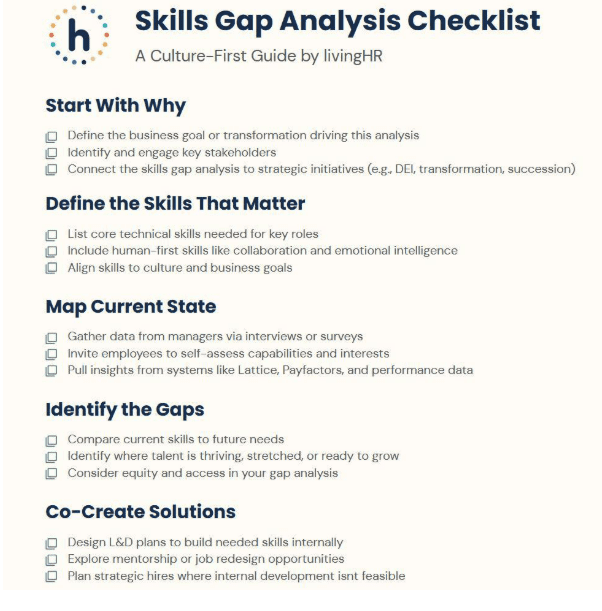
Plus, use this template for skill gaps analytics to decide on the level (individual or team-wide), person in charge, timeframe, and the proper method of bridging the divide.
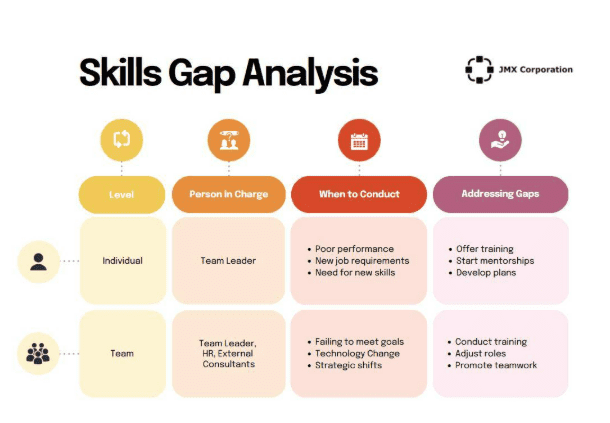
Although hard skills like artificial intelligence are a must-have these days, as 76% of professionals claim they need to become AI-fluent to stay competitive in the job market, we’ll focus more on soft skills, which are no less significant in the future of work.
The Most Typical Soft Skill Gaps in Teams and Proper Training for Each
Communicative Skill Gap
Have you ever been to a meeting where every team member nodded with “Yep,” but eventually left it with different project visions or even failed because of misunderstandings?
That’s this skill gap in action. When co-workers can’t properly understand each other, when they don’t listen actively, or when they can’t provide constructive feedback without igniting a workplace conflict, here’s what happens next—internal communications mess up or even break down altogether. In fact, conflicts between colleagues account for nearly half (47%) of all grievances at work.
But then, in particular, there may be a wide cross-generational divide in communication between age-diverse employees. It’s quite typical for companies with the younger employee generation, Gen Z, joining the workforce. That’s where the conflict of interests, values, or other factors may arise between younger and older colleagues at work.
The top 3 Outback training programs to bridge this skills gap →
Emotional Resilience and Adaptability Skill Gap
According to McKinsey’s research, only 23% of workers are both resilient and adaptable to change. Others are in deficit of these crucial soft skills in the workplace.
While emotional resiliency is a bounce-back muscle, adaptability is a flex-muscle that should be trained in teams. Have your employees worked out both? You can figure it out with a comprehensive skills gap analysis and only then launch the right training program.
The top 3 Outback training programs to bridge this skills gap →
Collaborative or Teamwork Skill Gap
Should we call it a “collaboration crisis” in the workplace?
Well, we might do just that. Here’s why: 64% of employees claim that poor workplace collaboration costs them at least three hours/week in lost productivity, and 41% consider quitting for that reason.
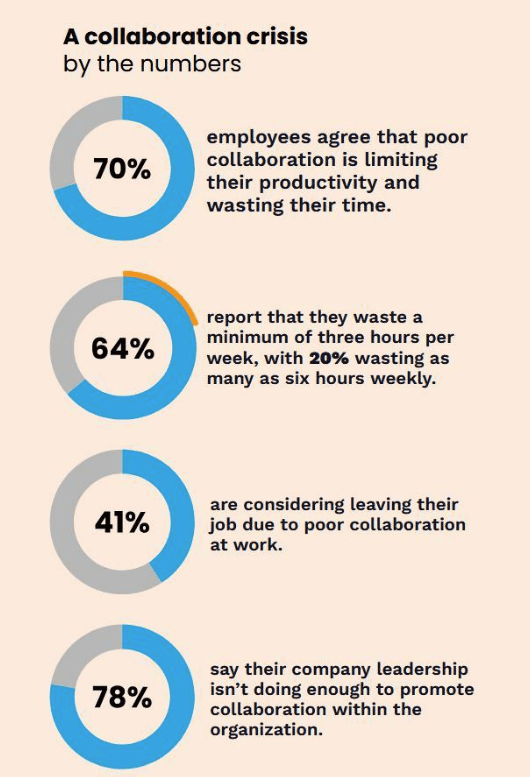
This is the time when teamwork transforms into a solo task for one person only. Alternatively, the problem can reach the other extreme when you start involving everyone in everything, aka over-collaborating.
The top 3 Outback training programs to bridge this skills gap →
- Discovering Workstyles with DiSC
- Positive Team Dynamics
- Building Strategic Teams with StrengthsFinder
Leadership/Management Skill Gap
Just because someone has the title and belongs to the leadership team (whether C-suite or lower-level) doesn’t automatically mean they have managerial skills.
Here are the most obvious warning signals that team leaders or managers are lacking it:
- Micromanagement
- Demotivation
- Disengagement
- Zero feedback
- Poor delegation decisions
- Inability to coach/mentor
In fact, two in five employees say their bosses have insufficient skills to perform their managerial roles. At the same time, even without conducting a skills gap analysis, 36% of middle managers feel they are not prepared for the people-leader role.
Then, Lacey Jarvis, COO at AAA State of Play, spotlights another challenge for today’s leaders, focusing on managing informational, financial, or other, but not human, resources. She says, “A lot of managers tend to focus on completing administrative tasks, analyzing business and finance data, and tackling problems rather than building the team. They literally can’t find time to manage. And that’s when developing the time management skill becomes essential in leadership.”
The top 3 Outback training programs to bridge this skills gap →
How to Perform a Skills Gap Analysis Prior to Any Training Program
Look at the Bigger Picture—Identify Your Team’s Needs for Competencies
It’s sometimes necessary to step off the chessboard to understand the game better and decide on your next winning move.
In the era of digitalization and tech transformation, what if it’s not about the soft skills? What if there’s a widening competency gap in your team related to future-ready hard skills?
These can be:
- Computer literacy
- Digital project management
- AI and ML
- Cloud computing
- Robotics engineering and manufacturing
- AR and VR
- Cybersecurity
- Or others.
For example:
When it comes to marketing, over 80% of CMOs believe there is a huge AI skills gap in their teams. In this context, to become high-performers, marketers must grasp innovative technologies like GenAI to generate keyword ideas for SEO or content for social media marketing. Using a keyword research tool can make this process faster and more accurate. It ensures that your content is targeted towards high-performing keywords.
However, in the opinion of Jeffrey Zhou, CEO and Founder of Fig Loans, it doesn’t always (and doesn’t necessarily in every industry) have to be a trendy skill like AI to invest in. “Before investing in corporate learning and development, you should analyze the market tendencies, your business needs, competitors’ strategies, etc. Only then can you pinpoint the topmost skills your employees need to perform better at work and drive your business to a successful future.”
For example:
Johnson & Johnson pioneered a system that follows the three-step process and predicts competency requirements for workers based on “industry trends, technological advancements, and strategic business forecasts.”
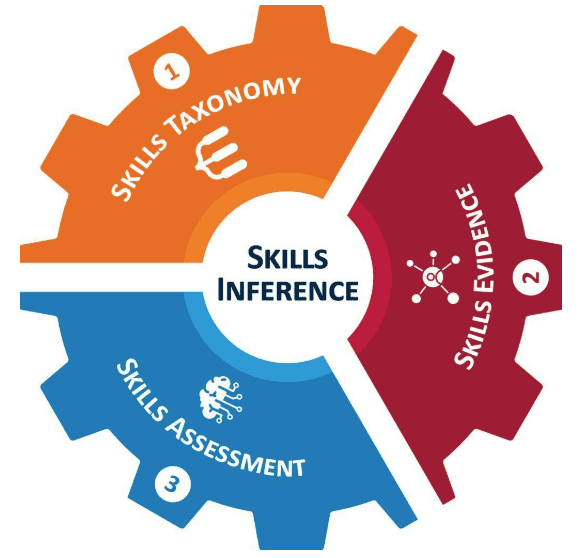
Test Your Workers’ Skills
“You can’t fix the problem if you haven’t actually diagnosed it. This statement is relevant when doing a skills gap analysis: you can’t close the divide if you don’t locate it first. Importantly, you should perform employee expertise check-ups and analyze skill gaps on a regular basis—ideally, once every quarter,” recommends Ben Bouman, Business Owner at HeavyLift Direct. The business leader additionally notes, “Even if everything looks fine, it’s better to stay ahead of the curve and address the skill deficiency before it turns into a serious bottleneck for the whole company.”
Indeed, in today’s fast-spinning world, competencies expire faster than yogurt in the sun. So, check them through:
- Self-evaluations
- Manager or peer-to-peer assessments
- Performance reviews
- 1-on-1 interviews
- Thematic trivia or quizzes
- Online testing platforms: TestGorilla, SkillsBase, TalentGuard, LinkedIn Skill Assessments, or others
- Gamified challenges (or even scavenger hunts)
Along with peer/manager feedback, digital assessment tools are among the top three preferred methods among organizations to document and validate workers’ capabilities.
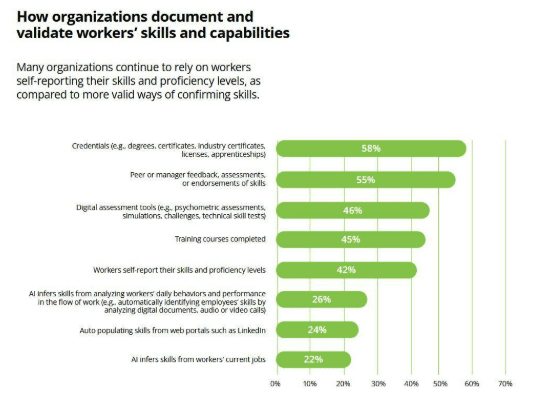
For example:
IBM uses an AI-powered skill testing system that provides feedback to workers on their competency levels and suggests learning resources in the “Your Learning” platform for employee development.
Outline the Training Scopes: Individual and Group
Some skill gaps are highly personal (like a lack of tech proficiency driven by the fear of using new technologies). Others are group-wide (like the team’s creative brainstorming sessions that end up in chaotic meme-sharing hours with zero productivity).
That’s why when you conduct a skills gap analysis, you should outline two scopes to effectively upskill or reskill employees on the individual, team, or corporate level.
Individual
For example:
Cisco created a dedicated hub, My Learning Network, for bridging skill divides on a personal employee level. It contains professional certifications and training resources on various topics, such as contact center performance, web security, resiliency, and more.
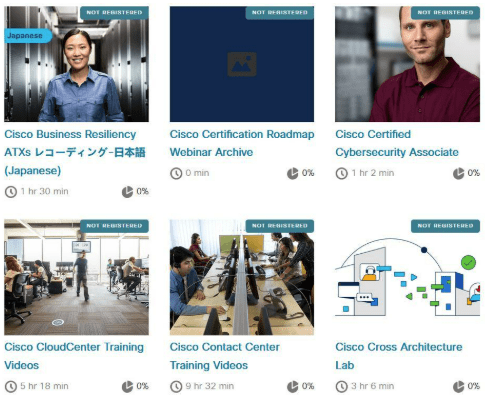
Team- or Company-Wide
For example:
Vision Credit Union brought together two leadership teams to learn how to communicate and engage more effectively with employees. They successfully closed this skill gap amid the Active Employee Engagement training program arranged by Outback.

Address the Widest Gaps First
Don’t try to train every skill and close every competency gap at once.
John Elarde III, Operations Manager at Clear View Building Services, suggests a mapping technique at the final point of any skills gap analytics cycle. “Draw an expertise map with broken circles as markers for skill gaps. Once you spot the largest divides, close those first. This strategy will help you as a manager set critical-level priority to the things that slow down your team most at this very moment.”
For that, you can use Skilbit, an employee skill mapping platform.
For example:
Once Principia saw the necessity to build a more emotionally aware and virtually connected team in a remote work environment, the company chose the Emotional Intelligence training program developed by Outback. Note: Outback’s training programs like these are also available in the in-person format.
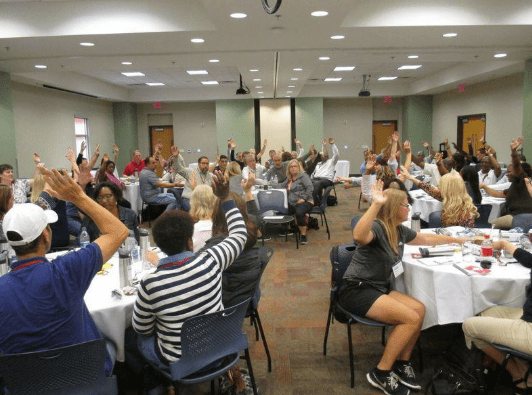
Close Skill Gaps in Your Team with the Right Training at Outback
Outback can help you build fast and smooth skill-boosting highways for your team members. From interpersonal skills to group leadership, bridge any competency gap or develop a custom training program for your specific needs and requirements with Outback.
Because the top-performing teams aren’t born with impeccable skill sets, they are trained.
Author Bio
Catherine Schwartz is an author who specializes in employee well-being and engagement.



